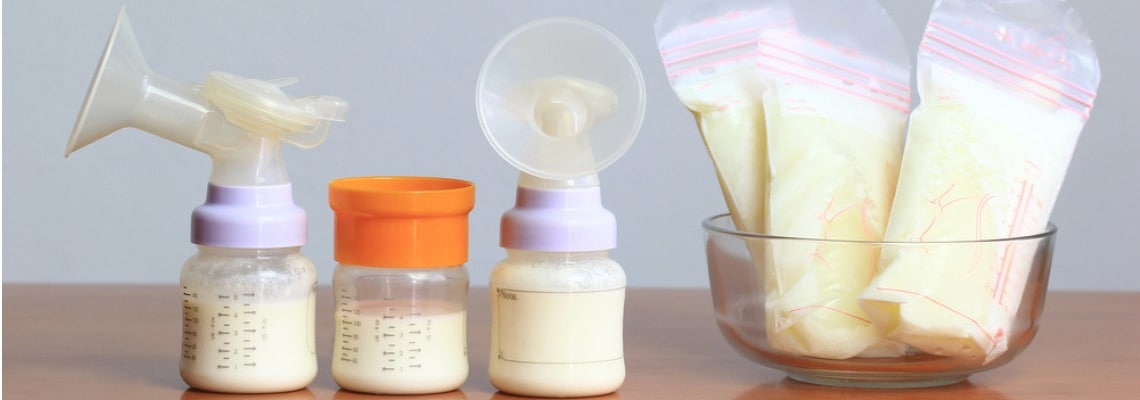
Breastfeeding your little one comes with a whole new world of things to learn. Many women are unaware that breastmilk can change in color, consistency, and supply depending on the mother’s health and lifestyle.
It is important to learn what some of these changes may be and why they occur to help ensure the best breastfeeding experience.
The Types of Breastmilk
Much like that of a cow’s milk compared to milk alternatives the color of milk can vary. Your body has the ability to match your changing baby’s needs as they grow. Your baby’s nutritional needs will naturally change as time passes. Your body has the ability to customize to their needs. Your milk will naturally progress in the beginning from colostrum to transitional milk then finally to mature milk.
 Colostrum is the thicker yellowish or bluish milk that is highly nourishing to your newborn child. It is the milk that you produce within the last few months of your pregnancy and the first few days after birth. This helps to keep your baby hydrated and to fight off infection.
Colostrum is the thicker yellowish or bluish milk that is highly nourishing to your newborn child. It is the milk that you produce within the last few months of your pregnancy and the first few days after birth. This helps to keep your baby hydrated and to fight off infection.
Transitional milk is a smoother, thicker milk that will appear white compared to colostrum. This is the milk that first appears while your body is transitioning to mature milk, usually during the first two weeks. This milk will gradually change from yellow to white.
Mature milk is what your baby will be eating after the first two weeks of birth. It can start out thin and watery, this is known as foremilk. But then it becomes thicker and creamer towards the end of a feeding. This creamier, thicker milk, known as hindmilk, has a higher fat content to help keep the baby full longer. This milk has a balance of fats, proteins, and carbohydrates to help keep baby nourished.The color of this milk can come in quite the variety.
What Causes the Color to Change
If you notice a strange color or odor from your nipples this may be due to the things you are eating.
Normal colors for milk will shift between white, off-white, and tan these are the natural composition of milk. If you notice that your milk seems less of a natural color this may be due to the food that you are consuming. This may be caused due to natural food colors, artificial food coloring, dyes, and nutrients. Changes like these are not harmful to the baby, as your body breaks down your food before it becomes your milk.
When breastmilk does change colors, it is usually more of a tint than a bright, noticeable change. Some of the colors that you may notice are :
- Green – This is commonly due to the consumption of leaves, green vegetables, roots, blue or green dyes, and possibly some supplements.
- Red or Brown – This may be due to food dyes, however, it is more commonly due to blood. This could be from a cut on the nipples or from inside of the breast. This is not harmful to the baby if it is in small amounts for a short period of time. If you notice blood in your milk for more than a week, it may be time to contact your doctor.
- Orange or Pink – This may be due to the consumption of red food dye, strawberries, or carrots. Small amounts of blood may also cause this coloring.
- Blue – This is a natural tint that is found within breast milk.
- Black – A medication that you are taking is usually the cause of this. However, if you have eaten dark food coloring this may be the culprit.
Stored Breastmilk
 When you pump and store breastmilk you may notice a change. In the refrigerator breastmilk may separate into layers. There might be a thick, white or yellow creamy layer on the top. Then a thinner clear or blue-tinted layer on the bottom. This is normal, as the milk sits the fat will rise to the top. Before you are ready to use the milk just swirl the bottle around to mix the milk back together.
When you pump and store breastmilk you may notice a change. In the refrigerator breastmilk may separate into layers. There might be a thick, white or yellow creamy layer on the top. Then a thinner clear or blue-tinted layer on the bottom. This is normal, as the milk sits the fat will rise to the top. Before you are ready to use the milk just swirl the bottle around to mix the milk back together.
Breastmilk stored in the freezer may also change colors. You may notice the milk appears more yellow once frozen.
Changes in Breastmilk Texture
The consistency and texture of breastmilk may change throughout breastfeeding. If you notice that the baby is sick, your breastmilk may revert back to colostrum to help boost the baby’s immune system. You may also notice your milk change back into colostrum when your baby starts to wean from the breast.
Breastmilk Supply
As you breastfeed, you will notice that supply and demand take on a whole new meaning. The more that your baby nurses from you or that you pump, the more that your body will produce. Your body is designed to keep up with the growing needs of your child.
However, if you do notice a drop in your supply this may be due to a few things. If you have previously pumped and have someone else feed your baby, it is important to pump again to help maintain your supply. When you go without pumping or nursing you are telling your body that you no longer need that milk for your baby. If you go on vacation or spend time away from your child, you will want to express your milk in order to maintain your supply.
Supply may also dip due to medical conditions, medications, or even your diet. It is important to make sure that you are eating enough calories and drinking enough water to help keep your supply up.
If you are worried about a dip in supply as time goes on, don’t be. Your body is designed to keep up with the demands of your baby as they grow. You should be able to produce the milk that your baby needs even when introducing solid foods to their diet!
When to Contact your Doctor
When it comes to breastmilk colors and texture, in most cases there is no need to seek medical attention. It is completely normal for your milk to change in color and smell throughout the day.
However, if you do notice that your milk is black or tinged with blood for more than one or two weeks you may wish to talk to your doctor. If you notice a strange color that you cannot explain, it may also be good to check with your doctor. Remember first that it may be due to the things you are eating, it helps to keep a record of your diet if you notice this trend to help determine the culprit.
It is also good to speak to your doctor before starting a new supplement or medication to make sure that it is okay to take while nursing.


